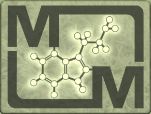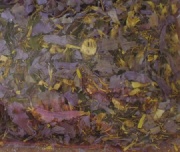 |
MAGISKA MOLEKYLERS WIKI |
Nymphaea caerulea
Namn: Egyptian Blue Water-Lilly (eng.), Egyptian Blue Lotus (eng.), Blå Lotus (sv). På Latin betyder Nymphaea caerulea den djupblå näckrosen.
Innehåll
[göm]Generell information
Blå lotus är namnet på en blåfärgad näckros som kommer ifrån Nilområdet och sydostasien. Den har funnits i över 160 miljoner år utan att ha undergått någon större förändring i sin struktur. Idag odlas och växer den runtom i världen. Bladen kan bli 40 cm i diameter. Blommorna kan bli cirka 15 cm i diameter, dessa reser sig ur vattnet vid soluppgången och dyker ner under vattenytan vid skymningen.
Släktingen Nymphaea alba (Vit näckros) är en vanlig växt som återfinns i dammar och sjöar i Sverige. Den tillhör samma släkte (Nymphaea) och sägs också innehålla aktiva ämnen.
Historia
Blå lotus har använts sedan forntiden och har betraktats av Grekerna, Indierna, Mayaindianerna[1], Japanerna och Kineserna som en gudomlig växt, en symbol för kvinnlighet, odödlighet, livet och utopi. I det antika egypten var blå lotus en högt värderad växt och omgavs av djup mystik. [2]
Den omnämns även i Odysséen. Odyssés och hans män besöker en ö vid Nordafrikas kust där lotofagerna (lotusätarna) bor. Besättningen konsumerar lotusblommorna och uppnår ett lycksaligt, glömskt tillstånd[3].
Om innehållet
Vad som orsakar den psykoaktiva effekten är inte helt utrett. Det finns spekulationer kring aporfiner, en grupp alkaloider som tillhör klassen kinolinalkaloider. Där finns bl.a molekyler som är partiella agonister på dopaminreceptorer av D2-typen och serptoninreceptorer av typen 5-HT1A. [4] Nuciferin (1,2-dimetoxi-aporfin) och apomorfin (6a-beta-aporfin-10,11-diol) är omnämnda kandidater och påverkar dopaminreceptorerna. [5][6]
| “ | The story of the sacred Blue Lotus makes a mockery of modern science. It has been known for several years now that this species is psychoactive to some degree, but little concrete knowledge exists in the scientific arena and the psychoactive effect is vigorously disputed by conservative scientists. So a couple of wiseguy pharmacologists decided to make a name for themselves by researching the active constituents and making a documentary about it. It is shown on the discovery channel and other media, and once youve experienced the effects of Blue Lotus you will understand just how ridiculous their research is. In years to come it will be better suited for the comedy channel.
First they compared the Mass Spectrometer analysis of a mummy with that of some Blue Lotus flowers with the result that they matched. This indicated that the mummy had consumed Sacred Blue Lotus not long before his death. They also looked for narcotics in the mummy and found none. The substances found were listed as phosphodiastrates, bioflavonoids and phytosterols. The first is similar to viagra, the second group is common in many fresh foods, and the last is similar to the known active constituent of Ginko biloba. At no stage in the research did they bother trying to consume a flower or an extract and this is where one has to wonder what the purpose of science is if it only serves to prove the absolute. The result of their expensive and drawn out study was that the mild activity of sacred Blue Lotus is due to the phytosterols. It is obvious that this conclusion can be dimissed as poor science, poor logic and above all poor representation of the lily itself. Blue Lotus was assumed to contain nuciferine (1,2-dimethoxy-aporphine) just like Nelumbo nucifera, but this does not appear to be so according to the MS data. Aporphine and Apomorphine (6a-beta-aporphine-10,11-diol) have also been excluded. Essentially this means that at this time no one knows what is causing the Blue Sacred Lotus to be a potent narcotic and inebriant. All we know is that 2-4 flowers soaked in wine for 24 hours will give a noticable and very pleasant synergy with the wine. Seed extracts and flower extracts can be consumed orally with or without alcohol, while dried flowers are easily dosed by smoking. All product forms will produce noticable effects. These can range from mild sedation to a fairly strong narcotic state. |
” |
Dosering och effekt
Blå lotus har en lugnande, hypnotisk och sederande effekt. Den påstås även ge CEV:s vid höga doser. Beskrivs ibland även som afrodisiakum
| “ | Recent studies have shown Nympaea caerulea to have psychedelic properties, and may have been used as a sacrament in ancient Egypt and certain ancient South American cultures. Dosages of 5 to 10 grams of the flowers induces slight stimulation, a shift in thought processes, and mild closed-eye visuals. Nymphaea caerulea is very often confused with Nelumbo nucifera, the blue lotus, which contains the alkaloid nuciferine, which has sedative and muscle-relaxing properties. The active principal alkaloid in Nympaea caerulea is currently unknown.
The flowers are rumored to contain aporphine, an entheogen that is purported to have divinatory properties, and nuciferine, an antispasmodic, but the Egyptian species have never been scientifically tested for these compounds. |
” |
Ett påstått traditionellt recept innebär extrahering av 100g blå lotus i kokande vatten, 2dl honung tillsätts, allt reduceras och den kletiga honungen med de aktiva ämnena droppas ner i 1 liter vin som får stå i en månad innan användning. En dos är 150ml. [9]
4g blad som extraheras i alkohol under en vecka, indunstas till ett svart klet som sedan kan vaporiseras. Denna metoden och dosen beskrivs av en person ge kroppslig avslappning, lätt förvirring men även stark eufori. [10]
Videoklipp
Här är dokumentären som omnämns i citatet ovan.
Sacred Weeds - Blue Lilly
Externa länkar
- ↑ Transcultural use of narcotic water lilies in ancient egyptian and maya drug ritual
- ↑ The Egyptian 'Lotus' - Nymphaea Caerulea, the Blue Water Lily
- ↑ Wikipedia: Lotus eaters
- ↑ 11-substituted (R)-aporphines: synthesis, pharmacology, and modeling of D2A and 5-HT1A receptor interactions (Hedberg, 1996)
- ↑ Psychopharmacological studies on (--)-nuciferine and its Hofmann degradation product atherosperminine.
- ↑ Differential Actions of Antiparkinson Agents at Multiple Classes of Monoaminergic Receptor. I. A Multivariate Analysis of the Binding Profiles of 14 Drugs at 21 Native and Cloned Human Receptor Subtypes
- ↑ Shaman Australis: Nymphaea spp. Pharmacology
- ↑ Wikipedia
- ↑ Traditional Lotus Wine - A Manual on Preparation and Effects
- ↑ Blå Lotus II, Angor experimenterar med extrakt
Sidan ändrades senast 10 januari 2015 klockan 17.17.
Den här sidan har visats 24 335 gånger.












